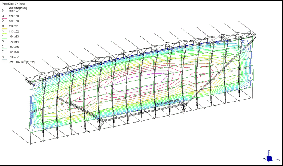
engineering & technology publications
ISSN 1759-3433
PROCEEDINGS OF THE SEVENTH INTERNATIONAL CONFERENCE ON COMPUTATIONAL STRUCTURES TECHNOLOGY
Non-linear FE Analysis of Tension Structures used to Stabilize the External North Façade of Pad 19-20 in the Fiera di Bologna: Comparison of Two Different Proposed Solutions
+Department of Structural and Transportation Engineering, University of Padua, Italy
*Department of Construction of Architecture, University IUAV of Venice, Italy
This paper shows the procedure used to obtain a tension structural solution for the
external Teflon façade (1070 m![]() ) of the Pad 19-20 site in Fiera di Bologna (Italy).
) of the Pad 19-20 site in Fiera di Bologna (Italy).
The authors present two different proposed solutions; a cable-beam system (adopted solution) and a cable-net system. Differences in mechanical response and solutions techniques for both options are highlighted and compared.
The procedure for determining State 0 is also presented with regard to the functional and structural conditions applied to the steel structure and membrane.
The numerical comparison between the two structural models leads to some observations which influence the choice of the most rational tension system solution to be adopted for the façade.
Analysing the displacement of the membrane under the effect of the wind load, we observe that the cable-beams system, thanks to its characteristic V shape, provides the best structural response. In particular, the V shape provides an initial rigidity without any initial displacement. Whereas, the cable-net system must reach an initial paraboloidic configuration to give its stiffness. This is clear considering the negligible curvature the cable-net has under no one load. The cable-net needs to deforms itself before to increase its stiffness according to its typical load- displacement hardening relationship.
Between the two models there is an important difference about the localization of the displacement. The cable-beam system has an independent response for each cable-beam, while the cable-net system provides a global behaviour similar to a continuous membrane.
Although the two systems have the same vertical load resultant, the cable-net system needs the pre-tension of the horizontal cable field (140 kN/each). It leads to a more rigid border structures.
Besides highlighting the greater sensibility of the vibration of the cable-beams system with respect to the cable-net system, no single common problem arose for both solutions. Both the solutions have a positive dynamic response for natural frequencies analysis and dynamic wind/seismic analyses. This analysis has been conducted considering all the masses and the stress state of State 0.
purchase the full-text of this paper (price £20)
go to the previous paper
go to the next paper
return to the table of contents
return to the book description
purchase this book (price £135 +P&P)

